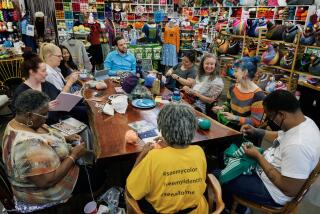Making Improvements to the Fabric of Life
- Share via
Sewing machines hum. Steam irons hiss. Happy chatter fills the room as 50 pairs of hands fly at their tasks.
The Afro-American Quilters of Los Angeles are having their first “quiltathon.” The goal of this four-hour Sunday afternoon sewing bee: to turn out 30 quilts for needy infants and children.
This has been planned with the precision of a military campaign. Weeks before, each woman in this quilting army was assigned a station, each station its generals.
There are cutters and sewers, pressers and tiers. And “birthers,” who sandwich the batting between the fancy top and the flannel backing, flip the bundle right side out and-- voila !--a quilt.
Event coordinator Sylvia Davis points to a bundle of symmetrically cut green and yellow scraps. “Dumpster fabric,” she says, retrieved from bins in the garment district. “We have some ladies who are willing to get in there and go for it.”
At a cutting table, Doris Parker lays a piece of white cloth on a grid, lines it up by ruler and slices through it with a device resembling a pizza cutter. These will be stitched together, then cut into patchwork squares.
Parker laughs as she recalls a non-quilter asking, “Why do you buy this fabric, cut it up into little pieces and stitch it back together again?”
A quilter knows.
Quilting is an addiction. Charter member Jo Syphax’s goal on a cross-country trip with her husband was “to stop in a quilt shop in every state.” By New York, their van overflowed with fabrics; she shipped those home so she could buy more coming West.
Some of the women sell their quilts but, for most, it’s a hobby benefiting family and friends. One took it up to keep her hands busy after she quit smoking. Another, given to insomnia, is a nocturnal quilter.
For most--like Emma Joy, a high school teacher--it’s pure relaxation. “You really need something to get that stress under control,” she says.
Whatever, the group has grown to 100. Monthly meetings at the Department of Water and Power auditorium on Crenshaw Boulevard feature “Show and Tell,” in which members display their new creations. African fabrics and themes are popular.
Want to learn? Veteran quilter Vera Stewart advises: “Start with a potholder, then go to a place mat . . . then you’re on your way to a wall hanging.”
A nice wall hanging may represent a month’s work and fetch $600 and up. Purists stitch by hand and command higher prices. For those with no quilt guilt, there are “cheaters,” with printed designs.
Dorothye Brandon, who exhibits and sells quilts to raise money for children with AIDS, is a hand quilter who shuns pattern books.
She loves “those old, old quilts that don’t match, with seams that don’t match, where they tore up this old shirt and that old skirt” for patchwork.
Before quilts were an art form, they were for keeping warm. The poor made them from feed and tobacco sacks. “That,” Brandon says, “is what makes quilting quilting.”
But Dora Simmons, an ex-upholsterer, is content to quilt by pattern. “I subscribe to 10 different quilting magazines, and I buy books.” Like many Afro-American Quilters, she learned to sew at her mother’s knee.
At last year’s African Marketplace, visitors to the quilters’ booth made crayon drawings on white fabric squares. That art, most of it by children, was heat-set and made into quilts.
Those and other quilts turned out at the quiltathon will be given to babies and children in county foster care, at King-Drew Medical Center and in the Great Beginnings for Black Babies project.
At day’s end, six quilts were finished; another 18 only needed tying, the final step, in which thread tufts are sewn through to prevent the stuffing from shifting.
Carrying a big roll of batting to her car, Sylvia Davis is well-pleased.
The Young Voices of Frustration
The theme was hopeful--”Increasing the Peace”--but there was an undercurrent of despair at a “kickin’ it” session at Central Juvenile Hall in honor of Martin Luther King Jr.’s birthday.
Sixty juvenile offenders, boys and girls as young as 13, joined in the open-mike forum arranged by the county Probation Department and KKBT (the Beat 92.3), which broadcast the three hours live.
Panelist Kershaun (Li’l Monster) Scott, 29, an ex-Crip who as a juvenile served seven years for crimes ranging from auto theft to first-degree murder, had some words about the company these kids keep:
“If they’re not tryin’ to keep you out of trouble, if they’re not tryin’ to keep you on a straight path, keep you out of here, keep you out of the cemetery, they ain’t your homeboys.”
“You can blame the system all you want,” said the Probation Department’s Jitahada Imara, but “it’s you who’s gonna stop drive-bys, stop killing, gonna stop the racial thing.”
KKBT personality Dominique De Prima, with her roaming mike, urged the kids to vent their anger and frustrations--with one proviso: “You can’t curse on the radio.”
Hear their voices:
“My daddy a Blood and I’m a Crip. It took me to find out that my own homeboys shot my daddy. I want to change my life ‘cuz his homeboys come back and shoot me and then I’m dead . . . all for what? For a color.”
“Open up some jobs . . . so we could stop robbin’ and stuff like that.”
“People be scared to go to school ‘cuz the gang members be there.”
“I been gangbangin’ since I was 8. I want to get out of this so bad it hurts.”
What would they like to tell the President?
“We don’t have places to go after school no more.”
“Dismiss the ‘three strikes, you’re out’ thing.”
Right, said another boy, but: “If we don’t give them a reason to use it, then what can they do?”
Rapper Coolio brought some words of street wisdom: “If you don’t know how to do nothin’, then that’s exactly what you’re gonna do.”
Many of these kids are victims of what one speaker called a “generational curse.” A girl of 13, who had run away from her placement, told of how she came to be in foster care:
“My mom’s ex-boyfriend threw a beer can at her and I went after him.” Her mom struck her--”She had fake nails on and they all popped off.”
Heads nodded when one boy said: “There ain’t nobody here you can really talk to and cry out to, you know, ‘Help me change my life.’ ”
How many of these kids will make it?
“Only a handful,” said panelist Richard J. Askey of the Martin Luther King Dispute Resolution Center, a former Juvenile Hall staffer. “Many are the offspring of institutionalized mothers and fathers. The overwhelming majority have already admitted defeat.”
Still, a boy, 17, who has been incarcerated twice for armed robbery and for carrying a concealed weapon, thought sessions like this might help kids in trouble.
“Maybe,” he said, “they’ll think back to this day” and remember that they have a choice.
* This weekly column chronicles the people and small moments that define life in Southern California. Reader suggestions are welcome.
More to Read
Sign up for Essential California
The most important California stories and recommendations in your inbox every morning.
You may occasionally receive promotional content from the Los Angeles Times.










